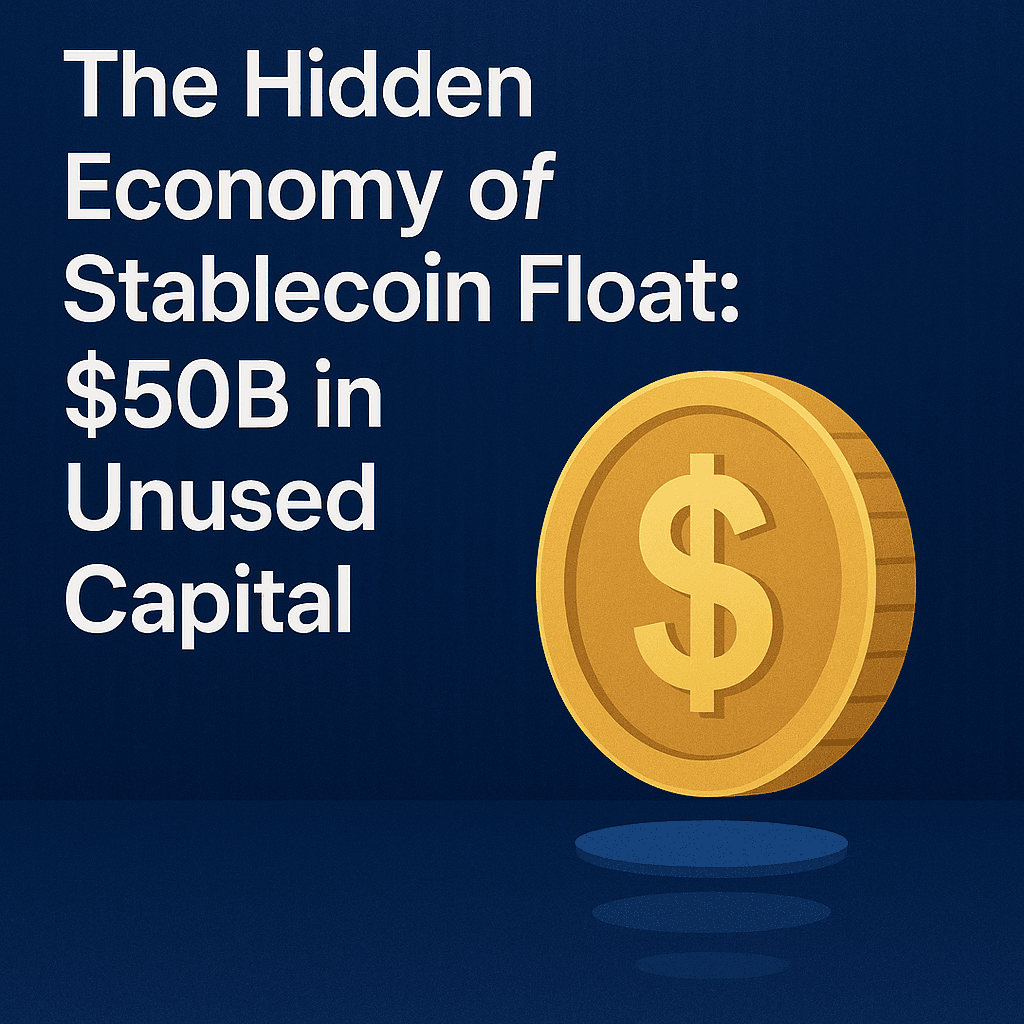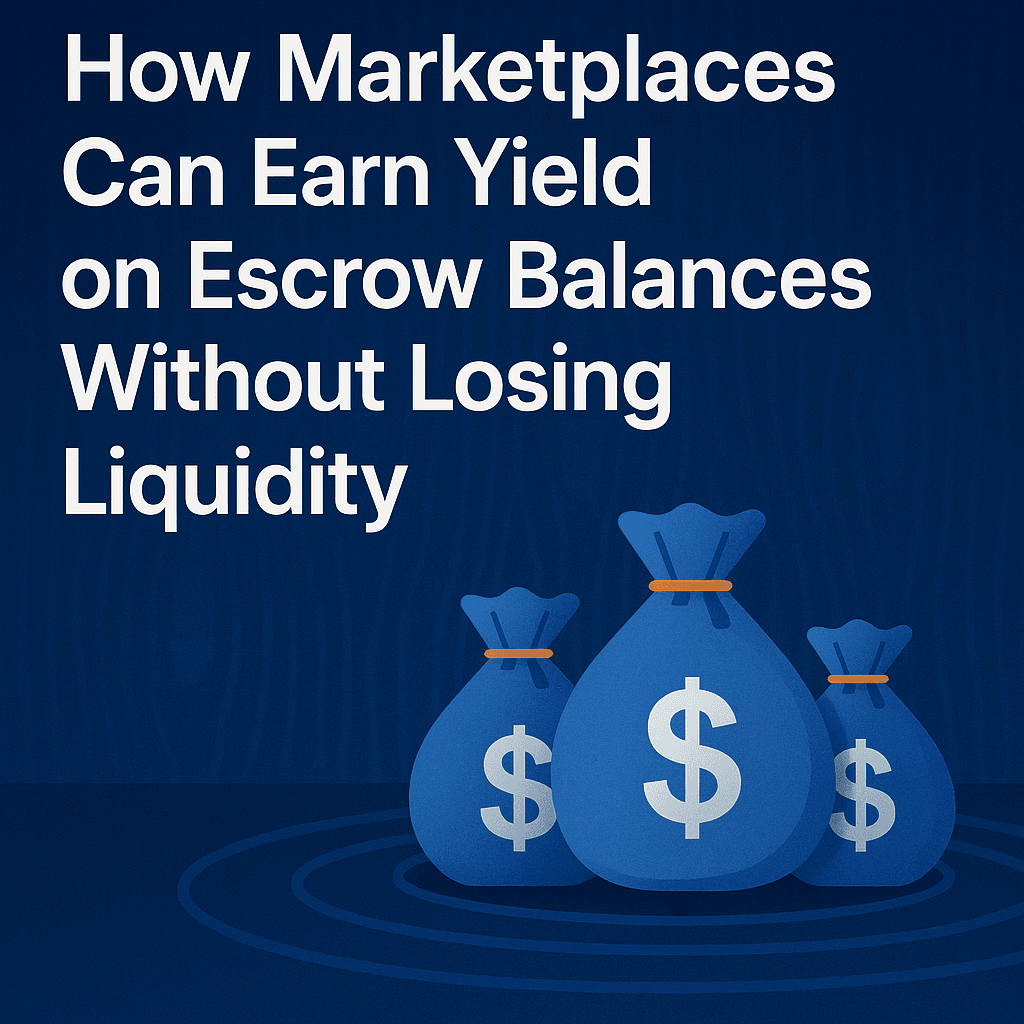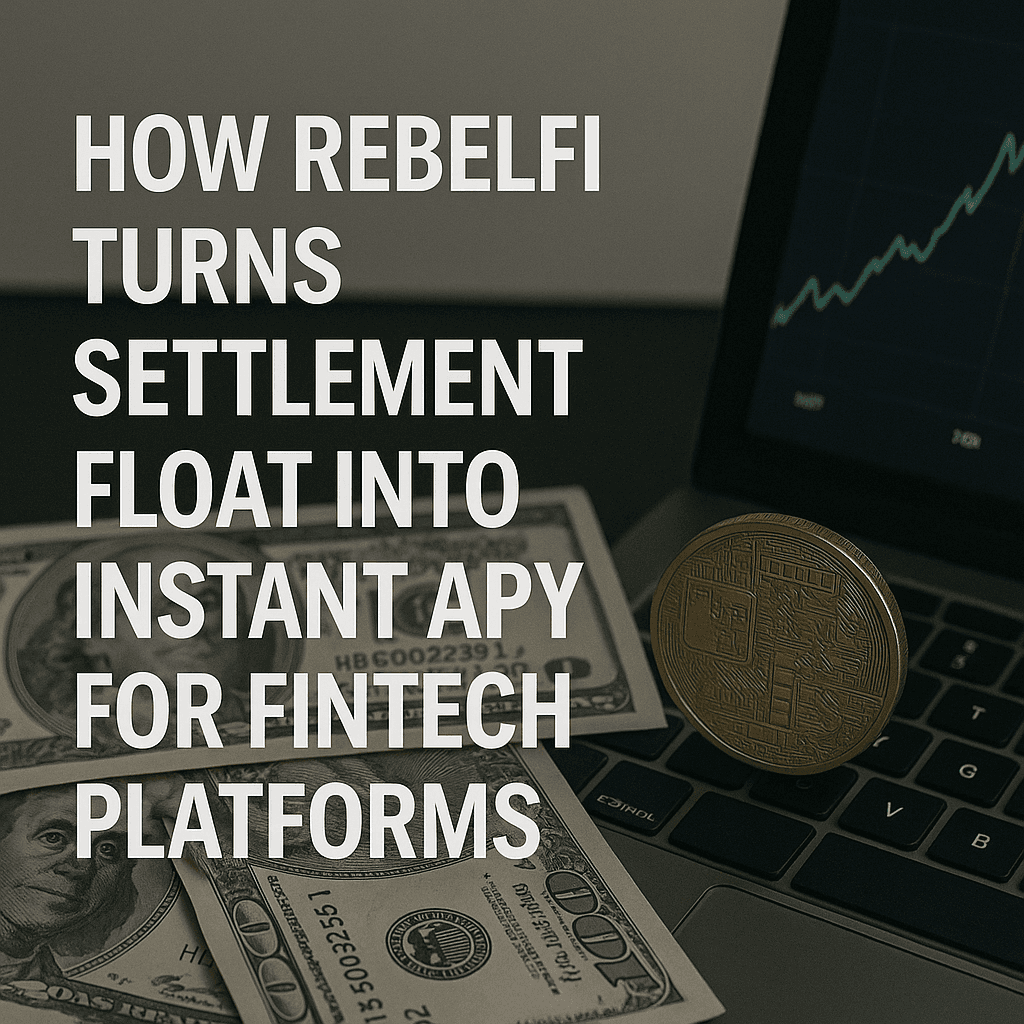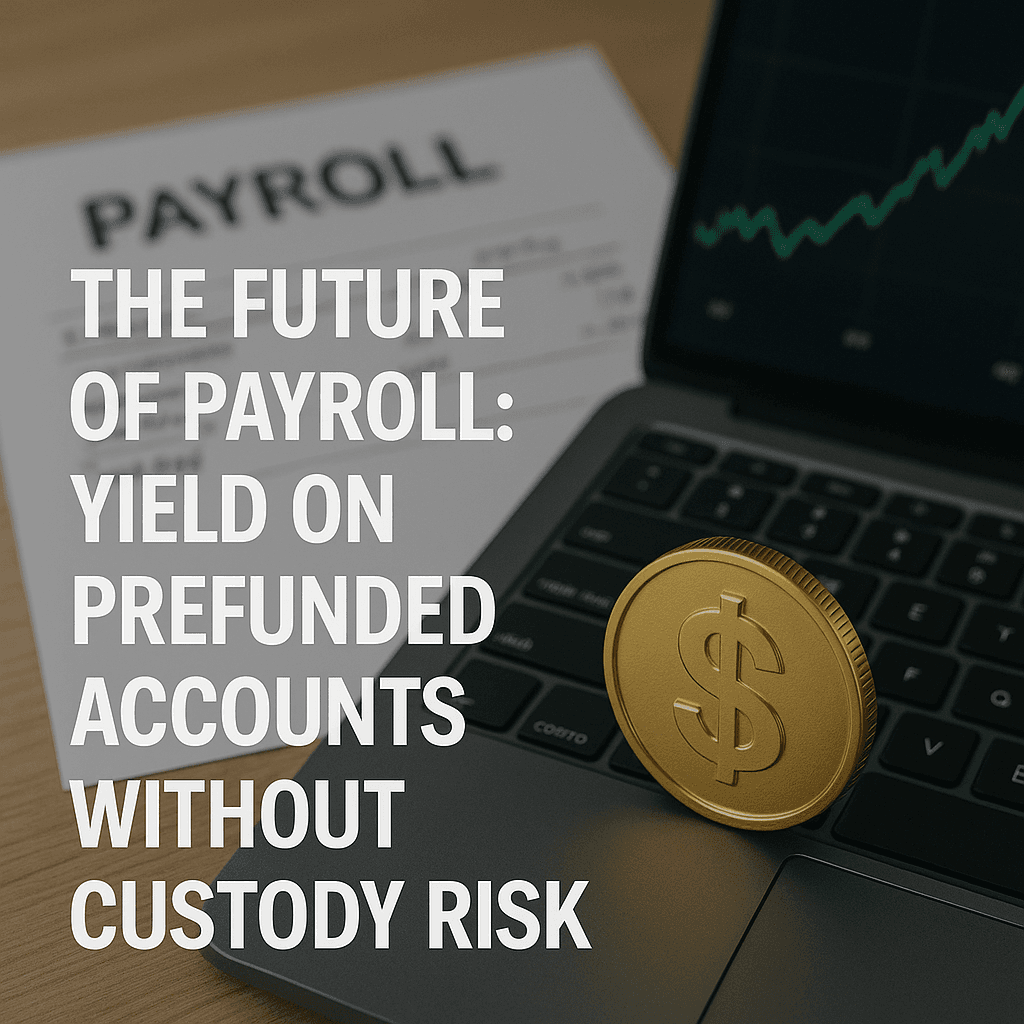The stablecoin economy crossed $300 billion in market cap in 2025, processing $94 billion in payments since January 2023. Yet beneath this growth sits a massive inefficiency: over $50 billion in idle stablecoin capital earning zero return while businesses continue paying transaction fees.
This idle capital, known as "float," represents one of the largest untapped opportunities in fintech. For payment processors and fintechs managing stablecoin operations, this capital inefficiency costs millions annually.
What Is Stablecoin Float and Why It Matters
Float refers to funds held temporarily between transactions. In stablecoins, float manifests in three critical areas:
Treasury Float: Reserves held for operational liquidity. Payment processors like ForumPay, which processes $50M+ weekly, maintain substantial stablecoin balances awaiting disbursement.
Payment Float: The gap between customer deposits and fund conversion. Paysolo, handling millions in monthly volume, holds significant balances during this period.
Settlement Float: Funds in transit during cross-border transactions. Even with fast blockchain settlement, businesses batch payments for efficiency, creating float windows.
The problem: this capital sits idle earning nothing while DeFi protocols offer 6-9% APY and tokenized treasuries provide 4-5% regulated yields.
The $50 Billion Opportunity: Breaking Down the Numbers
Current market data reveals the scale of this inefficiency:
B2B Payment Float
B2B stablecoin transactions hit $36 billion annualized as of February 2025, according to Artemis research. Monthly volumes surged from under $100M in early 2023 to over $3B by 2025, a 30-fold increase.
Conservative estimate: businesses hold 5-7 days of transaction volume in operational float, representing $500-700M in idle capital from B2B flows alone.
Payment Processor Reserves
Major processors maintain operational reserves of 10-20% of weekly volume. With billions in weekly processing across the industry, this translates to several billion dollars in aggregate float at any moment.
Treasury Management Balances
Beyond transaction float, businesses maintain liquidity reserves. The stablecoin market's $300B+ includes substantial holdings by payment companies requiring immediate access but not deploying funds productively.
The Real Cost
Combining operational float, treasury reserves, and custodial balances suggests $50B+ sits idle industry-wide. At 7% APY, this represents $3.5B+ in annual opportunity cost that businesses leave on the table.
Why Traditional Solutions Fail
The stablecoin float problem persists because existing approaches create critical dealbreakers:
Custody Transfer Problems
Most DeFi yield strategies require transferring custody to smart contracts, which creates immediate issues for regulated institutions:
Regulatory barriers: Banks and licensed fintechs cannot transfer custody without extensive legal review
Operational needs: Businesses need instant access to funds; protocol lock-ups are untenable
Audit complexity: Traditional accounting struggles with decentralized protocol holdings
Technical Barriers
Direct DeFi interaction requires specialized expertise most treasury teams lack:
Smart contract development and security auditing
Multi-protocol management across different blockchains
Ongoing protocol monitoring and risk assessment
Liquidity Constraints
Payment processors need immediate capital access. Many yield strategies involve lock-up periods, withdrawal delays, or slippage risk on large redemptions that conflict with operational requirements.
The Programmable Yield Solution
Modern programmable yield infrastructure solves these problems by maintaining operational flexibility while generating returns:
Custody-Agnostic Architecture
Leading platforms operate without custody transfer. Businesses maintain full control using existing solutions (Fireblocks, BitGo, Tatum) while receiving intelligent yield optimization:
No regulatory hurdles from custody transfer
Instant fund access maintained
Existing audit processes remain intact
Complete operational control preserved
Automated Intelligence
Rather than requiring DeFi expertise, programmable infrastructure analyzes opportunities across protocols and presents optimized strategies:
Real-time monitoring
of yields across DeFi, tokenized treasuries, and regulated products
Risk-adjusted returns
factoring protocol security, liquidity depth, and performance
Liquidity matching
ensuring funds availability when needed
Multi-Source Optimization
Sophisticated platforms don't rely on single protocols:
DeFi integration offering 6-9% APY on stablecoin deposits
Tokenized securities like Franklin Templeton BENJI providing institutional-grade 4-5% returns
Dynamic rebalancing capturing optimal returns while managing risk
Real-World Financial Impact
The numbers speak clearly across business scales:
Mid-Size Operations
A processor handling $10M monthly volume maintaining $2M in operational float (20% reserve):
Current state: $0 annual return
With 7% yield: $140,000 additional revenue
Impact: Directly offsets operational costs without business changes
Large-Scale Platforms
Companies processing $50M weekly maintain larger reserves:
Conservative estimate: $10M average daily balance
Current state: $0 annual return
With 8% yield: $800,000 additional revenue
Impact: Covers substantial technology infrastructure costs
Industry-Wide Calculation
$50 billion idle capital across ecosystem
7% average yield potential
$3.5 billion aggregate annual opportunity
This represents one of fintech's largest sources of untapped value.
How Programmable Infrastructure Works
Understanding the mechanics clarifies why modern solutions succeed:
Position Analysis: Continuous monitoring of stablecoin balances, transaction patterns, and liquidity needs.
Opportunity Matching: Algorithms identify yield opportunities matching business constraints and risk parameters.
Strategy Execution: System generates specific transaction recommendations with expected returns and risk profiles. Businesses review and approve through existing custody infrastructure.
Ongoing Optimization: Real-time performance tracking, automatic rebalancing recommendations, and protocol health monitoring.
Beyond Basic Yield: Advanced Opportunities
Programmable infrastructure unlocks additional value beyond simple yield:
Payment Timing Optimization
Strategically delay non-urgent payments to maximize float earnings while maintaining service levels.
Float-Funded Discounts
Generate enough yield to offer early payment discounts. Example: 2% discount for 30-day early payment funded by 0.5% monthly float yield.
Treasury Arbitrage
Exploit timing differences in settlement windows, cross-border transit, and batch processing to capture additional value.
Implementation Strategy
Successfully deploying programmable yield requires addressing key considerations:
Integration Requirements
Native support for major custody providers
API integration for seamless transaction execution
Compatibility with existing operational workflows
Risk Management
Protocol health monitoring and automatic mitigation
Diversification rules limiting concentration risk
Emergency liquidation procedures
Compliance Alignment
Complete audit trail generation
Accounting system integration
Jurisdictional requirement compliance
Industry Adoption Accelerating
Forward-thinking companies are already implementing these solutions:
Market indicators show accelerating adoption:
Regulatory clarity: GENIUS Act creates frameworks for yield-generating operations
Technical maturity: Blockchain infrastructure reaches institutional-grade reliability
Competitive pressure: Early movers force broader market adoption
Treasury evolution: Finance teams recognize stablecoin management as core competency
The Future of Stablecoin Treasury
This opportunity signals a fundamental shift in treasury management:
From Static to Dynamic
Traditional treasury treats capital as static. Programmable infrastructure makes it dynamic by default, where every dollar is productive until needed.
From Manual to Autonomous
Current operations require constant oversight. Programmable systems enable increasing autonomy with automated opportunity identification and self-executing strategies.
From Siloed to Integrated
Tomorrow's treasury systems integrate yield seamlessly into business operations, with ERP systems, payment processors, and banking platforms offering native yield features.
Getting Started: Practical Steps
For businesses ready to capture their stablecoin float opportunity:
Week 1-2 (Assessment):
Calculate average daily stablecoin balances
Analyze transaction patterns and liquidity requirements
Estimate opportunity cost at current 6-9% yields
Week 3-4 (Infrastructure Selection):
Evaluate custody compatibility
Assess risk management frameworks
Review compliance capabilities
Month 2-3 (Pilot):
Allocate portion of idle capital
Test operational workflows
Validate reporting integration
Month 4+ (Scale):
Increase capital allocation
Refine strategies based on patterns
Integrate more deeply with operations
Conclusion: Capturing the $50B Opportunity
The stablecoin float represents $50B+ in idle capital industry-wide, creating a $3.5B+ annual opportunity. For individual businesses, this means hundreds of thousands to millions in additional revenue from capital that currently earns nothing.
Modern programmable yield infrastructure solves the custody, technical, and operational barriers that previously prevented businesses from capturing this value. Early movers are establishing competitive advantages through improved economics, enhanced value propositions, and efficient capital utilization.
The hidden economy of stablecoin float won't remain hidden. Businesses implementing programmable treasury solutions now will lead the emerging category, turning idle capital into sustainable competitive advantage.
The infrastructure exists today. The question is when you'll start capturing it.
About RebelFi: RebelFi builds programmable stablecoin infrastructure enabling businesses to earn yield on operational capital without transferring custody. Our platform integrates with existing custody solutions, provides intelligent yield optimization, and maintains operational flexibility businesses require. Learn how RebelFi can help capture value in your stablecoin float at rebelfi.io.



